Baltic pickles stay crisp for months due to several key traditional techniques. You'll need to start with firm cucumbers like 'Delikateß' or Kirby varieties, then soak them in ice-cold water for up to 12 hours. The magic happens when you combine precise salt ratios (3-4.5%) with oak leaves' natural tannins, while maintaining strict temperature control during processing (180-185°F). A special Baltic vinegar blend at 5% concentration helps preserve crunchiness, and proper cellar storage at 40°F with 85-95% humidity keeps them firm. These time-tested methods hold centuries of pickling wisdom waiting to be discovered.
Traditional Baltic Pickling Heritage
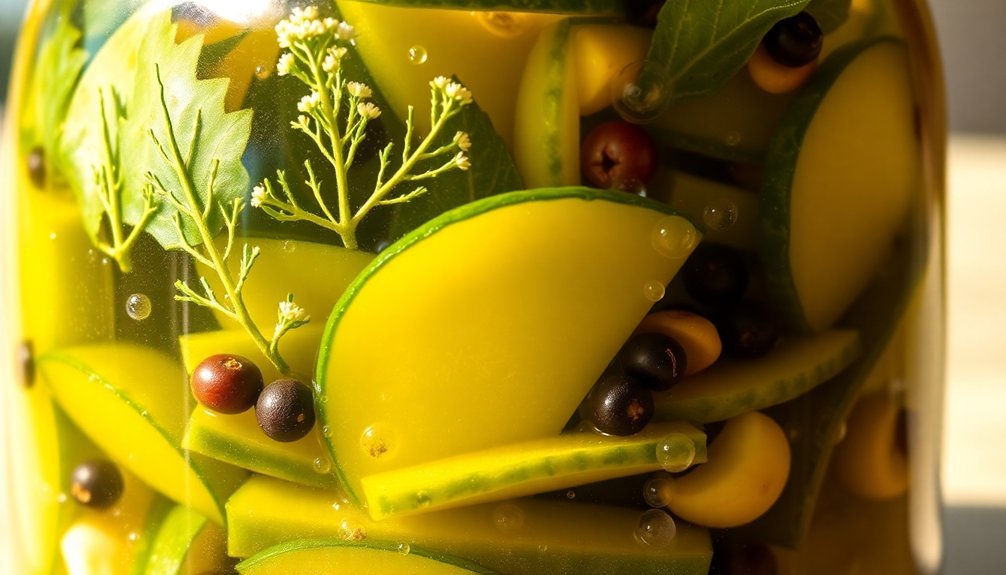
Three ancient practices laid the foundation for Baltic pickling: brining, fermentation, and canning. When you look at traditional Baltic methods, you'll find that brining was the most essential step, where foods were submerged in a salt-water solution with vinegar and spices. This solution worked to keep harmful bacteria at bay while allowing beneficial bacteria to flourish. The process helped create complex flavor profiles that developed gradually over time.
You'll discover that pickling wasn't just about preservation – it was a communal tradition that brought people together. In Baltic communities, housewives would gather to prepare winter provisions, storing their fermented goods in cellars and outhouses. The process was particularly important for preserving herring, a dietary staple that Jewish traders helped distribute throughout Europe.
If you'd visited a Baltic household during winter months, you'd have found their shelves stocked with pickled vegetables and fish that added both nutrition and flavor to otherwise bland meals. The tradition served poor communities especially well, as it allowed them to preserve affordable ingredients for extended periods.
Today's Baltic pickling methods still reflect these time-tested techniques, combining salt, garlic, and precise fermentation to achieve that characteristic crispness.
Perfect Cucumber Selection
Several essential factors determine the success of Baltic pickling, starting with proper cucumber selection. You'll want to focus on specific varieties like 'Delikateß', 'Vorgebirgstrauben', or Kirby cucumbers, which maintain their firmness during fermentation. Avoid English cucumbers, as they'll become too soft. Snake cucumbers are also not recommended as their dark green smooth skin makes them better suited for fresh eating.
| Cucumber Type | Characteristics | Best Use |
|---|---|---|
| Gherkins | Small, firm, 5-10cm | Whole pickle jars |
| Kirby | Medium, thin-skinned | Spears or chunks |
| Lemon | Yellow, round shape | Specialty pickles |
For ideal results, select cucumbers between 5 and 15 cm long with thin, unblemished skin. You'll get better brine absorption and crunchier pickles if you choose specimens that are freshly harvested. Don't wait more than 2-3 days to process them after picking. Remember to remove both blossom and stem ends, as these can cause softening and bitter flavors.
When preparing your cucumbers, slice them uniformly at about 1/8" thickness. If you're using larger varieties like Lebanese cucumbers, cut them lengthwise first. Before pickling, soak them in cold water or brine to enhance their crispiness.
The Cold Water Secret
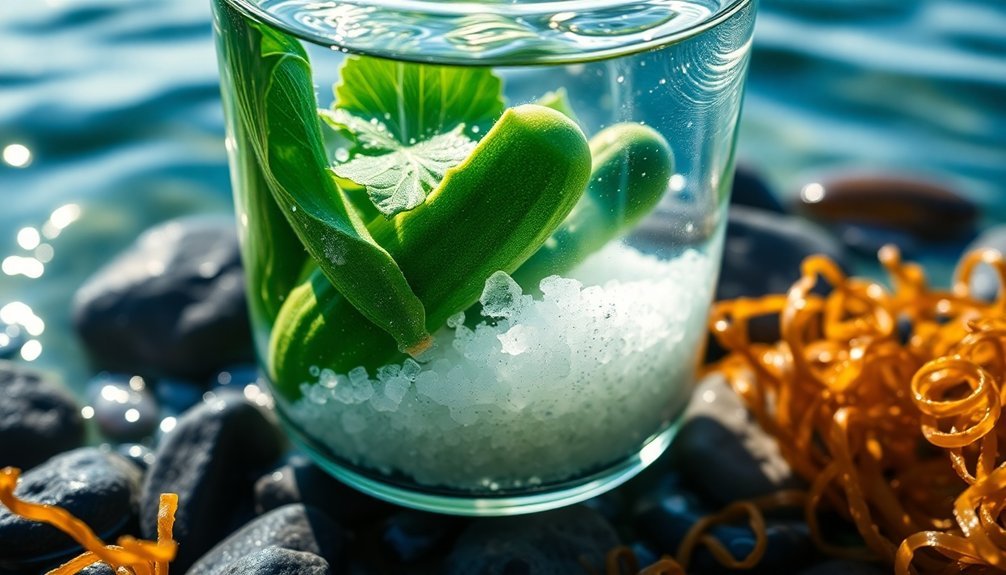
After selecting the perfect cucumbers, you'll need to master the cold water technique that professional picklers swear by. This essential step helps draw out excess moisture from your cucumbers while maintaining their signature crunch. You can soak your cucumbers in ice water for anywhere between 3 to 12 hours, which greatly slows down the natural softening process caused by the vegetables' enzymes.
For even better results, you'll want to combine this cold water soak with salt. This enhanced bath creates an environment that makes your cucumbers noticeably crisper before you begin the actual pickling process. Pickling cucumbers are the only variety that should be used for best results. If you're not ready to pickle immediately, you can store your cucumbers in this cold salt water solution for up to a week in your refrigerator without losing quality.
While your cucumbers are soaking, don't forget to trim off the blossom ends. This small but important step removes enzymes that could make your pickles soft and cloudy later. You'll only need to cut off a tiny sliver – the stem end can stay intact.
This combination of cold soaking and proper trimming sets the foundation for remarkably crispy pickles.
Salt Ratios Matter
You'll need to be precise with your salt measurements, as the wrong ratio can ruin your Baltic pickles by either preventing fermentation or allowing harmful bacteria to grow.
Your choice of salt matters too – mineral-rich varieties like Celtic Sea Salt or Himalayan salt help maintain the signature crunch of Baltic pickles while enhancing their flavor.
The density of your brine solution directly impacts the texture of your pickles, with a 3% concentration (7 grams of salt per cup of water) being ideal for shorter fermentation periods, while a 4.5% solution works better for longer ferments.
Scientific Salt Proportions Required
Getting the salt ratio right is absolutely vital when making Baltic pickles, as it determines both the safety and success of your fermentation. You'll need to follow precise measurements to create the perfect environment for beneficial bacteria while preventing harmful ones from developing.
| Brine % | Salt Per Cup | Best For |
|---|---|---|
| 3% | 7g (1 tsp) | 3-5 day ferments, half-sour results |
| 3.5% | 9g | 5-7 day ferments, balanced flavor |
| 4.5% | 10.8g | 14-21 day ferments, full sour taste |
You can't compromise on salt levels – they're essential for drawing moisture from the cucumbers and replacing it with brine. In hot weather, you'll want to use a higher salt concentration of up to 5.4% (3 tablespoons per quart of water) to prevent spoilage. The salt doesn't just affect taste; it's vital for controlling enzyme activity that maintains your pickles' signature crunch. Remember, reducing salt isn't an option – it'll compromise both safety and texture. Your brine concentration directly impacts fermentation time: lower salt levels work for quick ferments, while higher concentrations are necessary for longer fermentation periods.
Mineral Content Enhances Crispness
The type of salt you choose plays just as big a role as the concentration in creating perfect Baltic pickles. When you opt for mineral-rich salts like Celtic Sea Salt or Himalayan Salt, you're not just adding sodium – you're providing essential minerals that help maintain the pickles' signature crunch.
These natural salts contain over 80 minerals that refined table salt lacks, creating an ideal environment for beneficial bacteria while enhancing texture and flavor.
For the crispiest Baltic pickles, you'll want to focus on these mineral-rich aspects:
- Choose unrefined salts that contain natural magnesium and trace minerals, which support the fermentation process without increasing sodium levels.
- Maintain proper mineral balance by using the right salt concentration, allowing lactic acid bacteria to thrive.
- Combine mineral-rich salt with calcium chloride (¼ to ¾ teaspoon per 1L jar) for enhanced crispness.
- Consider adding natural tannins from grape or oak leaves to work alongside the minerals for maximum crunch.
The minerals in your salt choice work synergistically with other ingredients, creating that distinctive Baltic pickle crunch that can last for months while providing additional health benefits that refined salts can't match.
Brine Density Controls Texture
Precise salt ratios form the foundation of perfectly textured Baltic pickles. You'll need to maintain a 3% salt concentration for safe fermentation, though you can increase this to 4.5% if you're planning for longer preservation periods.
The right salt balance creates an environment where beneficial bacteria thrive while harmful ones can't survive.
You'll want to use pickling salt specifically, as it dissolves quickly and won't cloud your brine. Don't use iodized salt, Himalayan salt, or sea salt – they'll introduce unwanted minerals that can affect both flavor and appearance.
Your brine should remain clear throughout the fermentation process; any cloudiness might indicate contamination or improper salt choice.
To maintain that signature Baltic pickle crunch, you'll need to pay attention to more than just salt content. You can add calcium chloride to prevent softening, and you should always remove the blossom end of cucumbers where softening enzymes concentrate.
Keep your fermentation temperature cool – warmer temperatures will result in mushier pickles, regardless of your salt ratio. Regular monitoring guarantees you'll achieve the perfect balance of flavor and texture.
Baltic Vinegar Blend Specifics
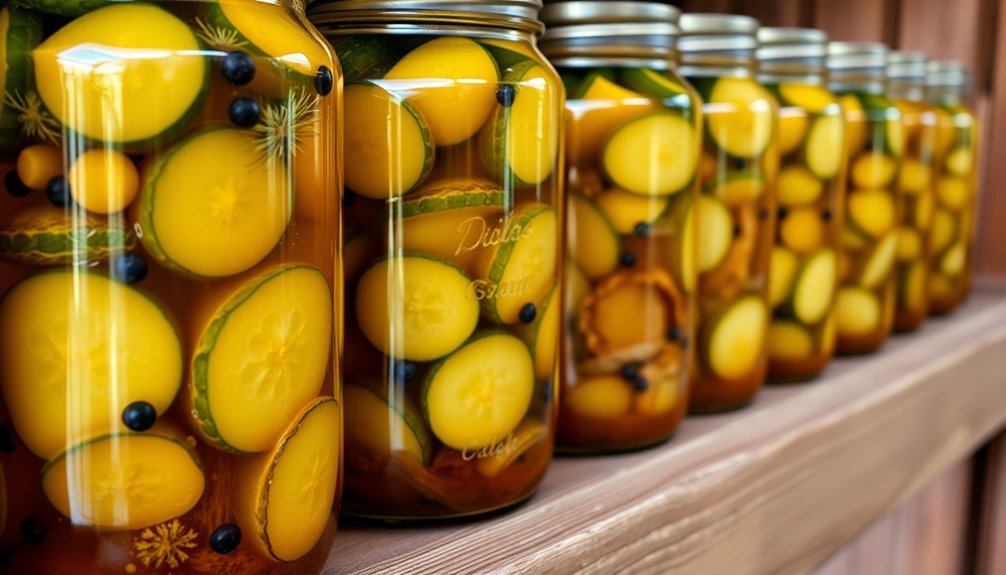
Crafting the perfect Baltic vinegar blend requires careful attention to both safety and flavor elements. You'll need to maintain a 5% vinegar concentration to guarantee proper preservation while avoiding higher acidities that aren't safe for consumption. The blend can incorporate various vinegar types, including malt, cider, or wine vinegar, along with carefully selected spices and seeds for authentic Baltic flavor.
When preparing your vinegar blend, you'll need to follow these essential steps:
- Start by selecting your base vinegar and calculating the proper water ratio (55% vinegar to 45% water for 4.5% acidity).
- Add your chosen spices, such as coriander seeds, mustard seeds, and peppercorns.
- Heat the mixture to a boil, then simmer briefly to infuse flavors.
- Cool completely before using for pickling.
Your blend needs to completely cover the pickling items, and you'll want to store the finished products in the refrigerator for up to six months.
If you're making gluten-free pickles, be sure to select certified gluten-free vinegar options like cider or wine vinegar. Remember to sterilize all equipment before starting to prevent contamination and guarantee the longest possible shelf life.
Temperature Control During Processing
You'll need to carefully monitor the temperature range of 180°F to 185°F throughout the processing of your Baltic pickles, using a reliable thermometer for precise readings.
When preparing your canner, start with warm water between 120°F to 140°F, then gradually increase the temperature while maintaining consistent heat levels to prevent pickle softening.
Remember to process your jars for exactly 30 minutes once you've reached the target temperature, ensuring the water level stays 1 inch above the jar tops for proper heat distribution.
Cold Brining Methods
Temperature control plays an important role in cold brining Baltic pickles. When you're preparing your pickling cucumbers, you'll want to maintain consistent cool temperatures throughout the entire process to guarantee ideal crispness and prevent unwanted fermentation.
Using cold water in your brine mixture helps preserve the cucumbers' firm texture while allowing the flavors to develop gradually.
To create the perfect cold brine for Baltic pickles, you'll need to follow these important steps:
- Dissolve 1/3 cup of pickling salt in 8 cups of cold water and 1/2 cup of white vinegar, making sure the solution remains cool throughout mixing.
- Pack your trimmed pickling cucumbers into clean jars with your chosen spices, leaving 1/2-inch headspace.
- Pour the cold brine over the cucumbers until they're completely submerged.
- Remove air bubbles and seal the jars before storing them in a cool place.
You'll need to let your pickles rest at room temperature for 24 hours before transferring them to the refrigerator.
The consistent cool temperature will help maintain the pickles' signature crunch while allowing the flavors to develop over the next three days before they're ready to eat.
Heat Control Techniques
Proper heat control stands at the heart of successful Baltic pickle processing. You'll need to choose between three proven methods: boiling water processing, low-temperature pasteurization, or atmospheric steam canning. Each requires precise temperature monitoring to guarantee both safety and that signature Baltic crunch.
If you're using low-temperature pasteurization, you'll want to maintain a steady 180-185°F for 30 minutes. Don't let the temperature fluctuate – going too low risks bacterial survival, while exceeding 185°F will break down pectin and soften your pickles. An Anova immersion circulator can help maintain this precise range, but a reliable candy thermometer works too.
For boiling water processing, you'll need to pack your pickles into hot, sterilized jars, remove air bubbles with a flat plastic spatula, and clean the rims before sealing.
If you opt for atmospheric steam canning, you'll use the same processing times as boiling water methods but with only 2 quarts of water instead of 16. Remember that processing times vary based on your altitude and the size of your pickle pieces, so follow tested recipes carefully.
Precise Temperature Monitoring
A precise eye on temperature control makes or breaks your Baltic pickle processing.
You'll need to start by filling your canner halfway with warm water between 120°F and 140°F, then add hot water until it reaches 1 inch above your jars. Using a calibrated thermometer, monitor the temperature until it hits the critical processing range of 180°F to 185°F.
During the 30-minute processing period, you must maintain this exact temperature range. Going above 185°F will break down the pectin and leave you with soft pickles, while dropping below 180°F won't properly eliminate foodborne pathogens.
Here's what you'll need to watch closely:
- Initial water temperature (120°F-140°F before adding jars)
- Processing temperature (maintain 180°F-185°F consistently)
- Processing duration (full 30 minutes at correct temperature)
- Cooling temperature (remove immediately after processing)
Once processing is complete, you'll need to remove the jars immediately using a jar lifter.
Place them on a cooling rack or heavy towel and let them cool undisturbed for 12-24 hours. Don't adjust the bands or press the lids until they're completely cool.
Oak Leaf Magic
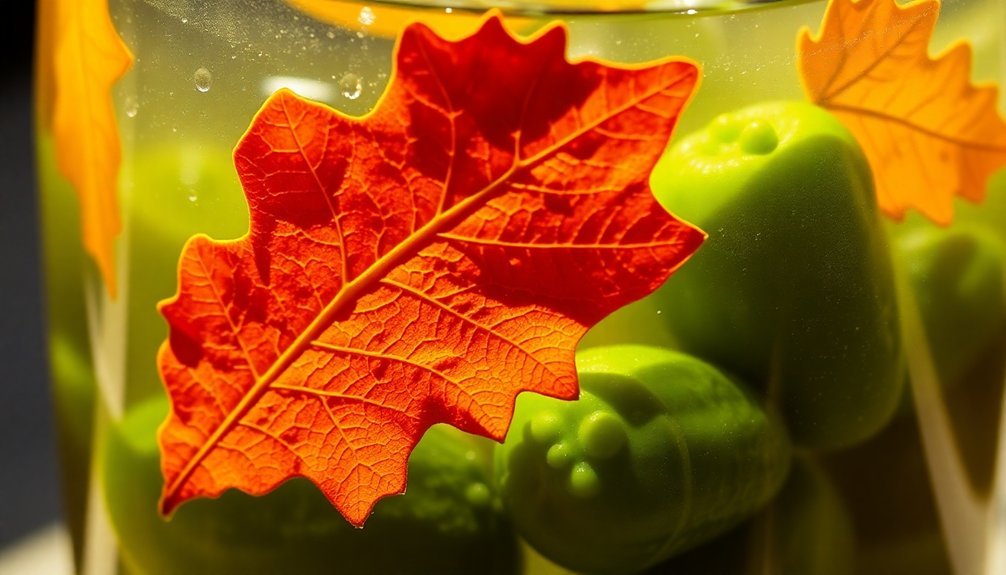
The humble oak leaf plays an essential role in the art of pickle-making, thanks to its remarkably high tannin content. When you add oak leaves to your pickle jars, you're tapping into nature's crispness preserver, as the tannins actively inhibit enzymes that would otherwise make your cucumbers go soft.
You'll want to use oak leaves sparingly since they're particularly potent. For ideal results, rinse the fresh leaves and layer them strategically among your cucumbers, dill, and garlic. They'll serve a dual purpose: releasing tannins while helping to keep your vegetables submerged in the brine.
If you can't find oak leaves, you've got several effective alternatives. Grape leaves are a popular choice, with three leaves per half-gallon being the standard measure. You can also use cherry, raspberry, or blackberry leaves, which all contain beneficial tannins. Even black tea leaves can step in as a substitute.
The magic of oak leaves isn't just in maintaining crunchiness – they'll contribute to a fuller flavor profile in your pickles. When combined with mineral-rich salt, these leaves guarantee your Baltic pickles maintain their signature snap for months.
Cellar Storage Methods
Once you've perfected your oak leaf technique, storing your Baltic pickles correctly becomes your next priority. Your cellar needs to maintain temperatures between 32°F and 40°F to preserve crispness and slow fermentation.
You'll want to keep humidity levels at 85-95% while ensuring proper air circulation by elevating storage shelves off the ground.
Your storage containers matter greatly. Use nonreactive materials like glass mason jars or food-grade plastic containers with proper sealing lids. For fermented varieties, keep the pickles submerged in brine using weights, and consider using airlock lids that can be switched to silicone stoppers for long-term storage.
Here's what you'll need to monitor regularly in your cellar:
- Temperature consistency – avoid fluctuations that can affect fermentation
- Humidity levels – use dehumidifiers if needed to prevent lid rust
- Light exposure – maintain darkness to extend shelf life
- Container integrity – check for lid rust and label condition monthly
For fermented Baltic pickles, prioritize refrigeration or cool cellar storage between 35°F and 40°F.
Keep the containers undisturbed to allow for slow, even fermentation, which contributes to that signature Baltic pickle crunch.
Frequently Asked Questions
Can Baltic Pickling Methods Be Used With Other Vegetables Besides Cucumbers?
You can apply Baltic pickling methods to many vegetables beyond cucumbers. The techniques work well with carrots, beets, green beans, and zucchini. Just verify you're maintaining proper salt ratios and freshness standards.
Why Do Some Baltic Recipes Include Cherry Leaves Alongside Oak Leaves?
You'll get better texture and balanced flavor when you combine both leaves. Cherry leaves offer milder tannins and less bitterness, while oak leaves provide stronger preservation properties. Together, they're more effective than alone.
Does the Mineral Content of Water Affect Baltic Pickle Crispness?
Yes, you'll find that high mineral content in water can negatively affect your pickle's crispness. It's best to use soft or distilled water to guarantee proper fermentation and maintain the crunchy texture you're looking for.
Can Baltic Pickling Techniques Work in Tropical Climates?
You can use Baltic pickling techniques in tropical climates, but you'll need to control temperature and humidity carefully. Using cool storage spaces and proper salt ratios will help maintain the fermentation process effectively.
How Do Traditional Baltic Pickle Recipes Vary Between Estonia, Latvia, and Lithuania?
You'll find Estonia favors dill-heavy cucumber pickles (hapukurk), Latvia specializes in diverse vegetable pickles with varied spices, while Lithuania's known for its mushroom pickling and regional variations in seasoning and ingredients.
In Summary
You'll find Baltic pickles maintain their signature crunch through a combination of time-tested methods. By selecting firm cucumbers, using cold water, precise salt ratios, and adding oak leaves, you're following centuries-old preservation techniques. Remember to store your pickles in a cool cellar and use the traditional Baltic vinegar blend. With these steps, you'll create perfectly crisp pickles that'll stay crunchy for months.

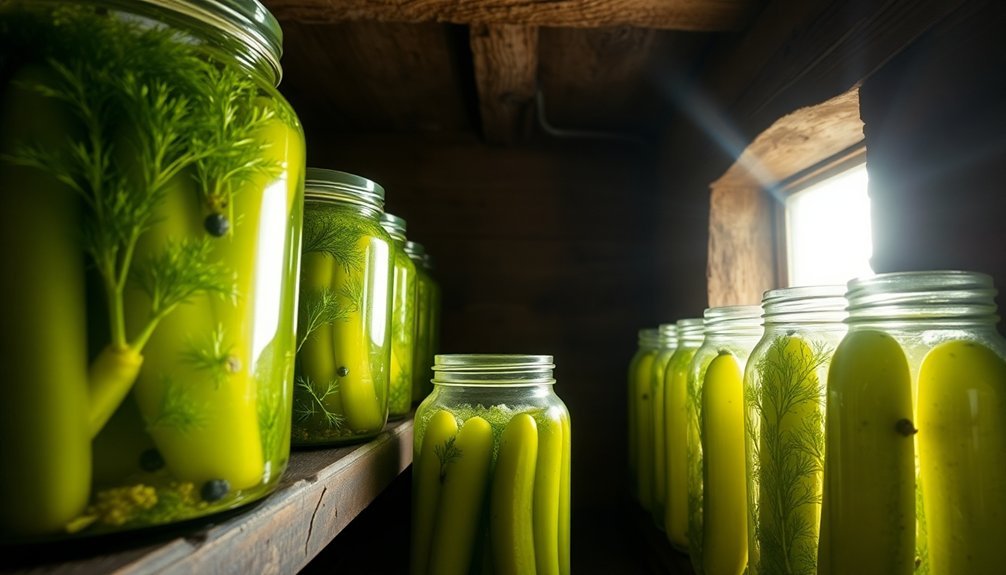



Leave a Reply